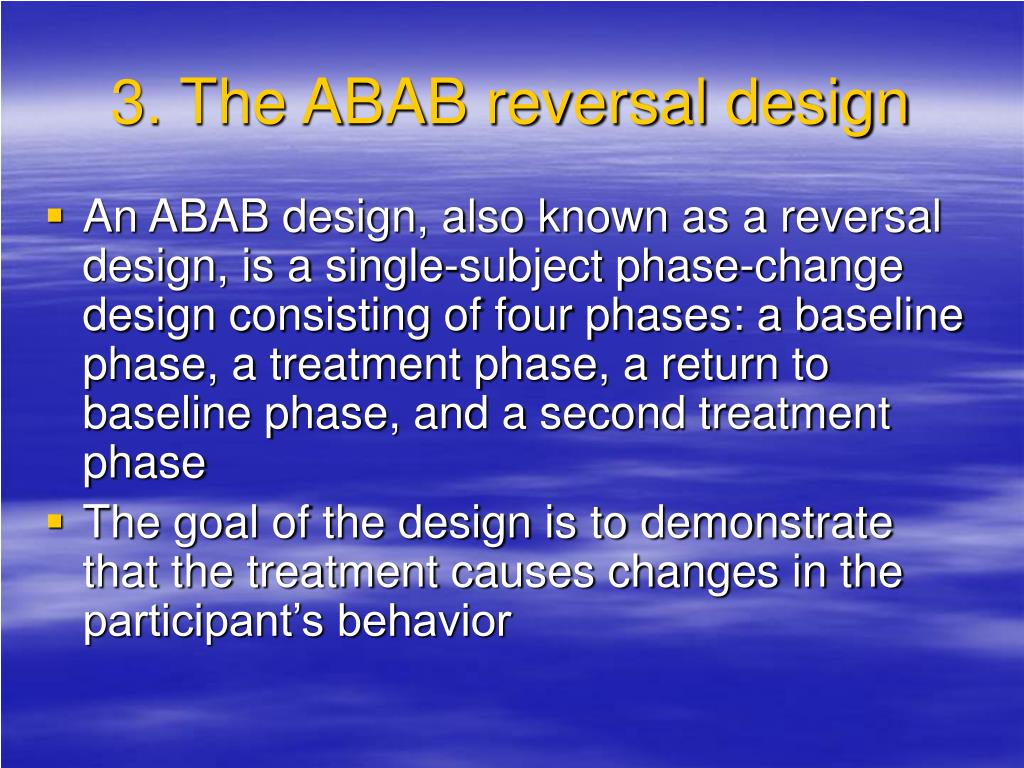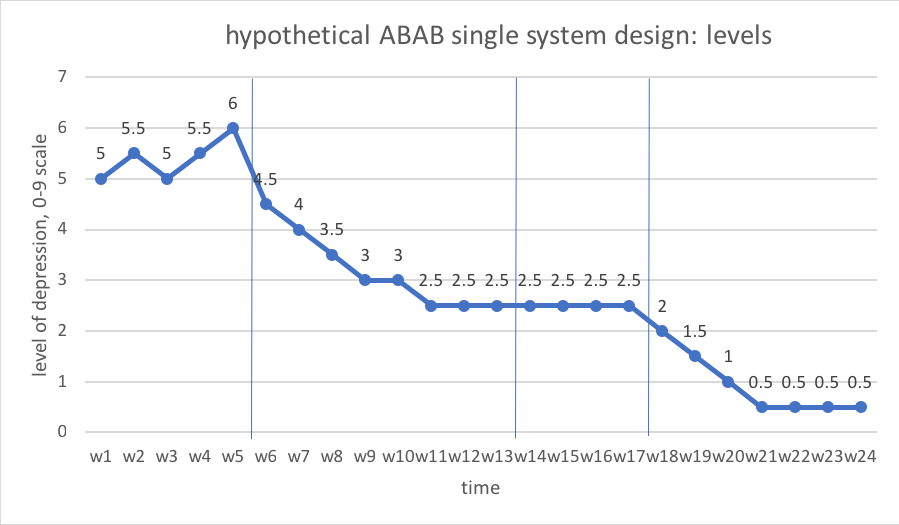Table Of Content

For example, several studies on incentive-based treatment to promote drug abstinence have used 20 participants in a reversal design [24, 25]. According to the SCD standards, there must be a minimum of three replications to support conclusions about experimental control and thus causation. Also, according to the SCD standards, there must be at least three and preferably five data points per phase to allow the researcher to evaluate stability and experimental effects [31]. As with each of the issues discussed in this section, there are advantages and disadvantages to the regression and non-regression methods for determining effect size for SSEDs. Nonregression methods involve simpler hand calculations, map on to visual inspection of the data, and are less biased in the presence of small numbers of observations (Scruggs & Mastropieri, 1998).
Breaking the Silence: The Impact of Emotional Exhaustion on Autism
This was because, in addition to meeting the minimum number of sessions per phase, it included a direct comparison between three conditions as well as a direct comparison with a baseline phase. The data from the baseline phase established that the participant did not respond correctly in the absence of the intervention. The data from the alternating treatments phase supported the effectiveness of the directed rehearsal and directed rehearsal plus positive reinforcement conditions compared with the control condition. They also supported the relative effectiveness of the directed rehearsal with reinforcement compared with directed rehearsal alone. In some cases, the simultaneous and continuous data collection in all legs of multiple-baseline designs is not feasible or necessary.
Main effects
Second, we did not investigate possible interactions between the various experimental factors, because these would be very difficult to interpret. However, these potential interactions might have an effect on the power of different types of data patterns, making it more difficult to formulate general recommendations. Taking the previous disclaimers into account, we can state that randomized AB phase designs in any case should contain more than 30 measurement occasions to achieve adequate power. Note that Shadish and Sullivan (2011) reported that across a survey of 809 published SCEDs, the median number of measurement occasions was 20, and that 90.6% of the included SCEDs had fewer than 50 data points.
Thriving with Autism and Behavior Problems
The duration of the ABAB design study can vary depending on the specific research question and the behavior being targeted. It's important to note that the ABAB design is just one of several research designs used in ABA. Other designs, such as randomized controlled trials and within-subjects designs, may also be employed depending on the research question and available resources.
Empowering Your Childs Progress in Autism
Figure 3 presents simplified examples of these two possibilities using a reversal design and short data streams (adapted from [69]). The panel on the left shows additive effects, and the panel on the right shows multiplicative effects. The data also can be analyzed to determine whether each component is necessary and sufficient to produce behavior change. For instance, the panel on the right shows that neither the component labeled X (e.g., self-monitoring of health behavior) nor the component labeled Y (e.g., counseling to change health behavior) is sufficient, and both components are necessary.

By carefully planning the design, researchers can minimize bias, increase internal validity, and draw accurate conclusions from their findings. A well-designed experiment allows for replication and generalizability of the results, enhancing the overall credibility of the study. There has been a small but steady body of work addressing effect size calculation and interpretation for SSEDs. Space precludes an exhaustive review of all the metrics (for comprehensive reviews, see Parker & Hagan-Burke, 2007, and related papers from this group).
Can Traumatic Events Trigger Autism?
(PDF) Creative Design Of Sitting Hug Machine In The Treatment Of Students With Autism - ResearchGate
(PDF) Creative Design Of Sitting Hug Machine In The Treatment Of Students With Autism.
Posted: Mon, 15 Oct 2018 23:01:36 GMT [source]
(The material below is adapted from [3]) There are also a number of variants of these designs, enabling flexibility in tailoring the design based on practical or empirical considerations [27, 28]. For example, there are several variants to circumvent long periods of assessing behavior during baseline conditions, which may be problematic if the behavior is dangerous, before introducing a potentially effective intervention [28]. Understanding the ABAB design is crucial for evaluating the effectiveness of interventions in the field of ABA. This design provides a systematic approach to assess the impact of interventions on the target behaviors of individuals with autism. However, it is essential to consider the advantages and limitations of the ABAB design when interpreting the results.
Coffees Potential Effects on Autism: What the Research Says
Specifically, the same teacher, materials, task demands, reinforcers, and reinforcer schedules were used in both the English and Spanish sessions. Percentage of unprompted questions asked by three participants in baseline, intervention, and generalization sessions using a multiple-baseline, across-participants design. From “Question-asking and collateral language acquisition in children with autism,” by Koegel, Koegel, Green-Hopkins, and Barnes (2010), Journal of Autism and Developmental Disorders, 40, p. 512. Overall, ABAB designs are one of the most straightforward and strongest SSED “treatment effect demonstration” strategies. Ethical considerations regarding the withdrawal of the intervention and the reversibility of the behavior need to be taken into account before the study begins. Further extensions of the ABAB design logic to comparisons between two or more interventions are discussed later in this article.
Sensory Table Ideas for Autism
We will limit the ANOVA to main effects because the interaction effects between the simulation factors were small and difficult to interpret. For each main effect, we will calculate eta-squared (η2) in order to identify the most important determinants of the results. Second, we will report the power for each specific AB data pattern that was included in the simulation study for both the MD and the ITEI. In these studies, the initial behavior is affected by the intervention, then the intervention is withdrawn to see if the behavior returns to the baseline level or is changed. The ABAB design is considered to offer stronger evidence of the effectiveness of a treatment since it involves adding and then withdrawing the intervention to observe changes in behavior, ultimately helping to identify the most successful intervention methods. One way to make initial efficacy testing more dynamic would be to conduct a series of single-case experiments in which aspects of the treatment are systematically explored.
If two components produce equal changes in behavior, and the same amount of change when both are combined, then either component is sufficient but neither is necessary. The main challenge in conducting a single-case experiment is collecting data of the same behavior or symptom repeatedly over time. If behavior or symptoms cannot be assessed frequently, then SCDs cannot be used (e.g., on a weekly basis, at a minimum, for most health interventions). For example, ecological momentary assessment (EMA) enables frequent input by an end-user into a handheld computer or mobile phone [15]. Such input occurs in naturalistic settings, and it usually occurs on a daily basis for several weeks to months. EMA can therefore reveal behavioral variation over time and across contexts, and it can document effects of an intervention on an individual’s behavior [15].

This pattern of results strongly suggests that the treatment was responsible for the changes in the dependent variable. And although there appears to be an increasing trend in the treatment condition, it looks as though it might be a continuation of a trend that had already begun during baseline. This pattern of results strongly suggests that the treatment was not responsible for any changes in the dependent variable—at least not to the extent that single-subject researchers typically hope to see. In addition to its focus on individual participants, single-subject research differs from group research in the way the data are typically analyzed. As we have seen throughout the book, group research involves combining data across participants.
The repeated cycles of adding and removing the intervention in ABAB designs can lead to faster results as individuals anticipate the reintroduction of the treatment. This method can be especially beneficial for individuals with autism, who may require more repetitions to understand and adapt to the intervention. Determining whether the results are clinically meaningful and socially valid can be informed by visual and most forms of statistical analysis (i.e., not null-hypothesis significance testing) [42, 63]. One element in judging social validity concerns the clinical meaningfulness of the magnitude of behavior change.
By understanding the differences between ABA and ABAB design, you can choose the right design for your research and achieve your desired outcomes. Data analysis for ABA and ABAB designs involves comparing observations during baseline phases with those during treatment phases. Statistical tests such as visual analysis, t-tests, and effect size calculations can be used to determine whether there was a significant change in behavior due to the treatment. They are commonly used in applied behavior analysis therapy for individuals with autism spectrum disorder and other developmental disabilities. Understanding the ABA design is crucial for researchers, practitioners, and caregivers involved in studying or implementing behavioral interventions.
In a reversal design, a treatment is introduced after the baseline period, and then a baseline period is re-introduced, hence, the “reversal” in this design (also known as an ABA design, where “A” is baseline and “B” is treatment). Using only two conditions, such as a pre-post design, is not considered sufficient to demonstrate experimental control because other sources of influence on behavior cannot be ruled out [31, 32]. For example, a smoking cessation intervention could coincide with a price increase in cigarettes.
Several conclusions can be drawn about the effects of the various components in changing behavior. The data should first be evaluated to determine the extent to which the effects of individual components are independent of one another. If they are not, then the effects are multiplicative, or the effects of one component depend on the presence of another component.

No comments:
Post a Comment